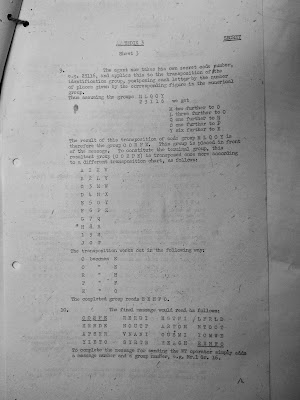A more detailed
analysis of the SOE ciphers and their indicator system is available from report
CSDIC (UK) S.I.R. 1106 ‘German
wireless intercept and counterespionage activities’ (Nov ’44) by Miersemann, a
member of Referat
Vauck.
Double transposition using a poem as a key
Standard
double transposition system using a poem as a ‘key’ generator. The words of the
poem are assigned a letter of the alphabet and the indicator is made up of the
letters assigned to the words used in the numerical key.
Then the
indicator is coded by using the agents secret number. For example if the
letters are MLOQY and the secret number is 23116, then the indicator becomes
M+2, L+3, O+1, Q+1, Y+6= OORPE.
The indicator
is placed as the first group of the message. The last group is again the indicator
but coded one more time with a different procedure. Using the following table
OORPE becomes EEHFO.
a
|
1
|
k
|
u
|
b
|
2
|
l
|
v
|
c
|
3
|
m
|
w
|
d
|
4
|
n
|
x
|
e
|
5
|
o
|
y
|
f
|
6
|
p
|
z
|
g
|
7
|
q
|
|
h
|
8
|
r
|
|
i
|
9
|
s
|
|
j
|
0
|
t
|
Double transposition with prepared
keys
Standard
double transposition system using prepared numerical keys (WOK-Worked Out keys).
Each set of keys has its own indicator. The indicator is placed as the first
and last group of the message. The second group of the message is the agents’ secret
identity code. This is coded using the following table:
a
|
1
|
k
|
u
|
b
|
2
|
l
|
v
|
c
|
3
|
m
|
w
|
d
|
4
|
n
|
x
|
e
|
5
|
o
|
y
|
f
|
6
|
p
|
z
|
g
|
7
|
q
|
|
h
|
8
|
r
|
|
i
|
9
|
s
|
|
j
|
0
|
t
|
For example
if the agents unique code is JTA then the 5-letter group is created as follows.
First letter is random let’s say C, second letter equals a number based on the
table above. For example H=8. This means that the letters of the agents code
are moved forward 8 steps, so:
J+8=R
T+8=B
A+8=I
So the group
will be CHRBI
Letter one-time pad and emergency LOP
Random letter
‘key’ coupled with the plaintext is substituted using a conversion table.
According to Miersemann the indicator of each key is enciphered by adding a
standard number (probably different for each agent).
For example
in the indicator OORPE 2 is added to O and 8 to P, which means that the new
indicator will be OQRXE. This is the first and last group of
the message.
The second
message group contains the agents’ secret number by using a number to letter
table. This is created by using the cipher indicator OQRXE. The numbers 1-9
plus 0 at the end are written out horizontally and the indicator beneath them.
Then the rest of the alphabet letters are written out, omitting those used in
the indicator. In our example:
1
|
2
|
3
|
4
|
5
|
6
|
7
|
8
|
9
|
0
|
O
|
Q
|
R
|
X
|
E
|
A
|
B
|
C
|
D
|
F
|
G
|
H
|
I
|
G
|
K
|
L
|
M
|
N
|
P
|
S
|
T
|
U
|
V
|
W
|
Y
|
Z
|
If the secret
number is 210 then this can be written as UGF.
Two dummy letters are inserted at the beginning to form a 5-letter group.
In the
emergency LOP three poems are used to create new ‘keys’ to be used with the
conversion table.
Pigeon
message:
While writing
this piece I thought of the pigeon
message mentioned some time ago in the media. The first group AOAKN is
repeated at the end so it must have been the indicator.
If the
message was WOK then the second group HVPKD could be interpreted as follows: H
dummy letter, V=2 using the WOK conversion table, PKD=agents id code, minus two
step=NIB. So maybe the Brits can find out who agent NIB was.
If the
message was LOP then the group HVPKD could be interpreted as follows: using the
indicator AOAKN the conversion table is:
1
|
2
|
3
|
4
|
5
|
6
|
7
|
8
|
9
|
0
|
a
|
o
|
a
|
k
|
n
|
b
|
c
|
d
|
e
|
f
|
g
|
h
|
i
|
j
|
l
|
m
|
p
|
q
|
r
|
s
|
t
|
u
|
v
|
w
|
x
|
y
|
z
|
Assuming that
HV are dummies, then this means that PKD=748.













No comments:
Post a Comment